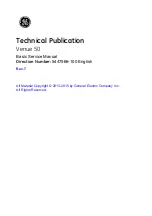
9
V. Maintenance
A. Error Codes and Corrective Actions
The instrument is supplied with self-diagnostic software to aid the user in the determination of problems. The software will
supply error codes that will direct the user towards specific corrective actions in the event of system failure.
ERR.1:
Signifies unstable infrared readings due to inconsistent sample gas supply or interference from strong electrical
fields.
Corrective Actions:
1.
If the error code occurs during a sample cycle verify that the sample hose is receiving sample gas from the
source connection of at least 5 psig. Also verify that the instrument sample exhaust and air intake ports are not
clogged or restricted.
2.
If the error code occurs during a calibration cycle verify that the air intake and sample exhaust ports of the
instrument are not clogged or obstructed.
3.
The unit should be kept away from sources of strong electrical fields such as large compressors, running
automobiles, etc. Move the instrument 3-5 feet away from the electrical field source and try again.
4.
If the instrument is being utilized outside of the operating temperature range of 45-100
o
F (7-38
o
C) allow the
instrument to warm or cool to the operating temperature range and try again. The instrument may require
additional warm up time after power up before use.
5.
To clear the error code power down the instrument. The error code will automatically clear.
DETECTOR FAULT:
Signifies internal infrared sensor failure due to temperature extremes.
Corrective Actions:
1.
Allow the instrument to stabilize at room temperature for at least 30 minutes before attempting use.
2.
To clear the error code power down the instrument. The error code will automatically clear.
CAL. FAULT:
Signifies an infrared calibration fault.
Corrective Actions:
1.
Verify that the air intake and sample exhaust ports of the instrument are not clogged or obstructed.
2.
If the instrument is being utilized in an enclosed area, refrigerant vapors may build up in the surrounding
atmosphere and be drawn into the intake port during calibration. Move the instrument to a location with fresh
ambient air free of refrigerant vapors. Use the instrument in locations that provide adequate ventilation to
prevent the accumulation refrigerant vapors in the surrounding atmosphere.
3.
Hang the unit so that there is a flow of fresh air around it.
4.
To clear the error code power down the instrument. The error code will automatically clear.
AIR SENSOR FAULT:
Signifies an air detection sensor calibration fault.
Corrective Actions:
1.
Verify that the air intake and sample exhaust ports of the instrument are not clogged or obstructed.
2.
If the instrument is being utilized in an enclosed area oxygen depleting compounds such as carbon dioxide or
carbon monoxide may accumulate in the surrounding atmosphere and be drawn into the intake port during
calibration. Move the instrument to a location with fresh ambient air free of oxygen depleting compounds. Use
the instrument in locations that provide adequate ventilation to prevent the accumulation oxygen depleting
compounds in the surrounding atmosphere.






























